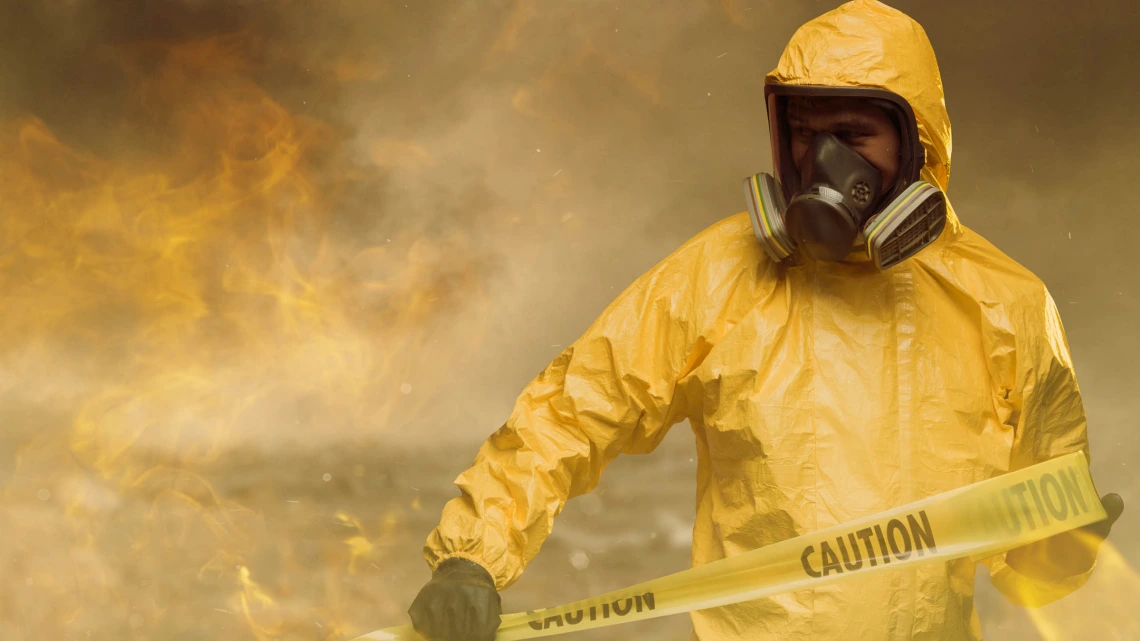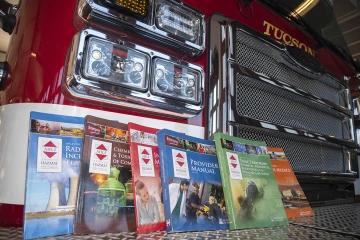Advanced Hazmat Life Support Keeps Good Chemicals from Going Bad
Interdisciplinary program trains first responders how to treat people exposed to chemical, biological and radiological hazards at home during peacetime and in conflict zones during wartime.

Training first responders and health care providers how to help people who have been exposed to hazardous materials around the state and around the world is the mission of the Advanced Hazmat Life Support team.
A Feb. 14 crash on I-10 south of Tucson that killed the driver of a truck carrying nitric acid and the Feb. 3 train derailment in East Palestine, Ohio, that forced responders to burn off vinyl chloride are sobering reminders that hazardous materials are everywhere.
As the one-year anniversary of Russia’s invasion of Ukraine approaches, a United Nations Environmental Programme environmental impact preliminary review cites “considerable environmental destruction” in Ukraine, that could face “a toxic legacy for generations to come” from the release of toxic chemicals in explosions.

Frank Walter, MD, a professor of emergency medicine at the UArizona College of Medicine – Tucson, and Jennifer Ronnebaum, manager of the Advanced Hazmat Life Support program.
First responders and elite military units were well-prepared to treat people exposed to hazardous materials unleashed in bombings, thanks to the training they received from the Advanced Hazmat Life Support (AHLS) program at the University of Arizona College of Medicine – Tucson.
But training the medical management of those exposed to hazardous materials during wartime is not the only treatment venue the AHLS team is involved with globally. Far more often, they are busy training first responders, nurses, pharmacists, physicians and other health care professionals in Arizona and local civilian communities around the world. Better preparing these interdisciplinary health care professionals to care for people exposed to common hazardous materials in their communities, such as the recent Tucson and Ohio incidents, are more common.
“Chemicals are not intrinsically good or bad; however, they can be used for good or bad purposes,” said Frank Walter, MD, a professor of emergency medicine at the UArizona College of Medicine – Tucson with an additional appointment in pharmacy practice-science at the R. Ken Coit College of Pharmacy. “Chlorine is used in water for purification and has saved billions of lives worldwide through water treatment; however, it was also used to kill and terrorize people in the wars in Syria and Iraq.”

AHLS manuals are shared with the Tucson Fire Department and other first responder groups around the state and globally.
Dr. Walter proposed that the AEMRC collaborate with the American Academy of Clinical Toxicology, a training program for physicians, nurses, paramedics, pharmacists, basic scientists and others worldwide. After 25 years, the collaboration between the AEMRC and the AACT is still going strong. The AHLS has now trained more than 22,000 health care professionals worldwide.
At UArizona Health Sciences, faculty from the colleges of medicine, pharmacy, nursing and public health can learn to medically manage patients exposed to hazardous materials using the latest guidelines. Graduates of the program can then train others how to treat exposed patients.
“It’s a ‘train the trainer’ model,” said Jennifer Ronnebaum, manager of the AHLS program.
“The first course was done in 1999 in Las Vegas. We have grown exponentially in the last 20 years. We have done training on the ground in 33 countries and have trained AHLS providers from 84 countries. We operate in eight languages.”
Like everything else, the COVID-19 pandemic necessitated expanding the AHLS’s on-the-ground training model with virtual options.
At UArizona Health Sciences, the Arizona Poison and Drug Information Center (AzPDIC) is a primary training ground. Farshad Shirazi, MD, PhD, the medical director of AzPDIC and a professor of emergency medicine in the College of Medicine – Tucson with an additional appointment in pharmacy practice-science at the R. Ken Coit College of Pharmacy, said AHLS training is mandatory for the center’s specialists. Physicians and pharmacists who pursue advanced fellowship training at the university to become clinical toxicologists are required to undergo AHLS certification and instructorship training.
“When somebody is exposed to hazardous materials …our goal is to be inclusive with world-class teamwork to provide the best possible patient care.”
Frank Walter, MD
Through the AzPDIC, the AHLS team trains medical and pharmacy students and residents at UArizona and Darnell Army Medical Center in Killeen, Texas, as well as paramedics in the Tucson Fire Department and other regional fire departments. Dr. Shirazi pointed out this is a natural extension of the poison control center serving the community, with training and real-time advice to health care professionals. The AzPDIC also provides real-time advice over the phone to community members who may be exposed to hazardous materials.
“We hire the largest number of clinical toxicologists in the university, and one of the core things we do is to prepare for hazardous materials incidents. So AHLS fits really well within our mission to care for people with chemical and other poisonous exposures,” he said, adding that medications, drugs, bites, stings, plants, mushrooms and radiation are all sources of potential poisonous exposures.
“We train medical students, PharmD students, emergency medicine residents, internal medicine residents, psychiatry residents, family practice residents and pharmacy residents,” Dr. Walter said, adding that over the years, UArizona College of Nursing students have also received training with a focus on preparedness led by Sally J. Reel , PhD, RN, FNP, BC, FAAN.
“AHLS has always been an interdisciplinary course, not only here, but worldwide,” he said. “We think that's absolutely critical, because when somebody is exposed to hazardous materials, from point of contact or point of exposure, through pre-hospital care by emergency medical services, through hospital emergency care, through hospitalization, and through critical care and rehabilitation, our goal is to be inclusive with world class teamwork to provide the best possible patient care."

In May 2022, the AHLS team provided training in Abu Dhabi, United Arab Emirates, one of many collaborations around the world. (Photo courtesy Carl Skinner)
That inclusiveness extends to working with the 2013 Nobel Peace Prize-winning Organisation for the Prohibition of Chemical Weapons (OPCW). In 2022, the AHLS trained OPCW health care professionals in Africa to care for those exposed to hazardous materials including chemical weapons.
“It's been really an honor and a privilege to collaborate with the winners of the 2013 Nobel Peace Prize, who have such a noble mission,” Dr. Walter said.
But the AHLS is also about keeping people safe here in Arizona.
“Hazardous material incidents can occur anytime, anywhere,” Dr. Walter said. “As you are driving down the street, whether you are in Phoenix or Tucson or anywhere, there are tanker trucks full of concentrated sulfuric acid. There are propane trucks, gasoline trucks, and hazardous materials carried by train, too. There are hazardous materials everywhere.”

